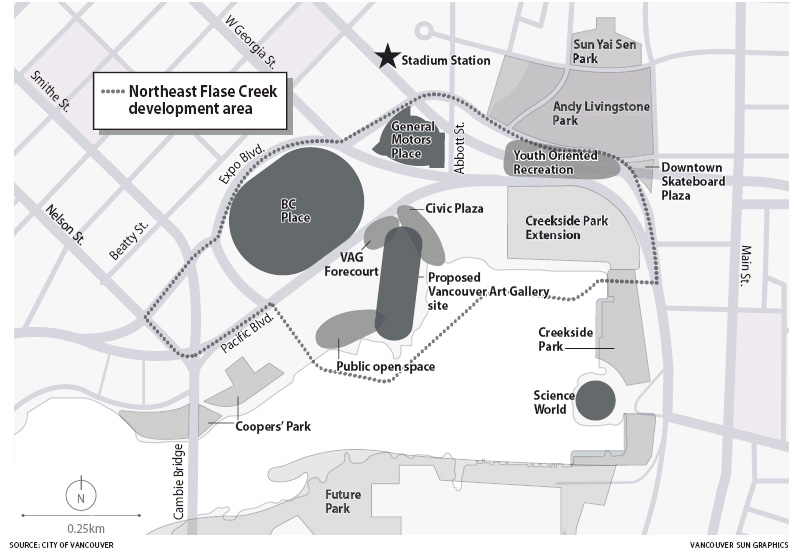Move would come at the expense of open public-space target of 2.75 acres per 1,000 people set in 1980s. In this plan, it drops to 1.8 acres
Kelly Sinoski
Sun

SOURCE: CITY OF VANCOUVER VANCOUVER SUN GRAPHICS
Vancouver is opting for denser communities at the expense of open public spaces in its bid to become the world’s greenest city by 2020.
The latest plan — endorsed by city council this week — to transform the former Expo lands in northeast False Creek into a neighbourhood for 7,000 people sets aside just 14 acres of the 72-acre parcel for public spaces and amenities.
This translates to about 1.8 acres per every 1,000 residents, well below a “desired target” of 2.75 acres set by the Vancouver park board in the 1980s. Planners had based the target on an amount historically provided to residents in new developments.
But as the city grows, it continues to struggle to provide affordable housing.
The push for denser downtown neighbourhoods is an experiment in urban living that counts on people accepting fewer public spaces in exchange for other amenities and a greener lifestyle.
The False Creek project is the latest example in a series of developments, including Coal Harbour, the East Fraser Lands and southeast False Creek, that have fallen below the park board standards for open space.
For North False Creek to meet the target, the city would have to add another 19.8 acres for public space.
“When you actually look at it, we’ve never achieved the standard,” Vancouver senior planner Michael Gordon said. “The denser you get, the more challenging it is.”
A city report co-written by Gordon says that the “new civic plaza and hard surface recreational area under the viaduct do not deliver the typical neighbourhood park” but are considered amenities.
The report also states there’s a wide array of open spaces and parks nearby.
Mayor Gregor Robertson argues that while most people would like to see more open spaces, the city’s hands are tied because the land base downtown is so limited. But he noted that about 80 per cent of Vancouverites live 500 metres, or five minutes, away from a public park or green space.
“Dense is critical for being green in an urban setting,” Robertson said. “It’s great to have bigger park spaces and we have a couple in Stanley Park and Pacific Spirit Park and the beaches, but downtown we have to shoot for greener objectives that are more realistic.”
That includes more creative use of public spaces and using money from developers to ensure green spaces are provided in the city, even if there is no room in the specific neighbourhood.
He noted that besides being sustainable, the development would create hundreds of jobs in the region.
“It’s a matter of having people living close to their jobs and there’s a number of people wanting to live in Vancouver,” Gordon said.
The northeast False Creek development is expected to be similar to Georgia Street west of Bute toward Coal Harbour, Gordon said.
City Coun. Suzanne Anton argued that while densification will see more people choosing transit and consuming less, it shouldn’t mean they have fewer public spaces or amenities.
“There’s going to be a lot of people living in the area; there has to be a place for kids to take swimming lessons or skating lessons,” Anton said. “I’m worried about the lack of public facilities there.”
But Maureen Enser, of the Urban Development Institute, agreed that northeast False Creek is the ideal location for higher density because it’s within walking distance of Stanley Park and the seawall, and is close to transit.
“From a sustainability perspective, density should be in an area like this because you have all the amenities close by already,” Enser said. “The need to increase the [open space] numbers per person is not as dramatic as other areas.”
However, park board commissioner Ian Robertson says the city and the Vision majority on council are catering to the demands of developers and adding to a continuing decline of park space throughout Vancouver.
Ian Robertson noted that Concord Pacific’s original plan for the area in the 1990s would have met park board standards, but that city council has continued to add more density in the development.
“We’re constantly looking at all quadrants and regions in the city where we’re park-deficient,” he said. “Certainly this is good for the developer, but not necessarily for residents of this neighbourhood.”
© Copyright (c) The Vancouver Sun
